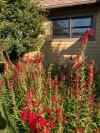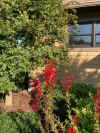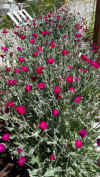LOBELIACEAE. Over 350 species ranging through most of the world and varying from annuals, perennials, aquatics, succulents and trees to caudiciforms above the treeline in African mountains in which gorillas make their nests. Many are excellent garden plants with showy flowers in mostly reds and blues. Many of the perennials prefer cool moist spots. Most easy from seed, surface sow, light helps. Some kinds need GA-3, prechill, or smoke.
—Lobelia cardinalis. (500) LOB-6. Packet: $2.50
1/4 Ounce: $10.00
Ounce: $35.00
Click for photo »


'CARDINAL FLOWER'. Bright, intense cardinal-red 1 - 2" long flowers in long spikes in summer. Hardy perennial to 2 - 4 feet, with glossy, narrow 4" leaves, often purple-bronze. E. N. America and a couple of disjunct spots in the Southwest. Zone 3. Best in wet soil and bogs. Makes nice colonies, and if flower spikes are picked, it will bloom till fall. Medicinal. Germinates in 2 - 3 weeks with GA-3.
—Lobelia Erinus 'Color Cascade'. (500) LOB-10CC. Packet: $2.50
5 grams: $7.50
25 grams: $30.00
Formula mix of blue, mauve, red, purple-rose, blue with white eye, and white. Trailing plants good in hanging baskets and window boxes.
—Lobelia Erinus 'Crystal Palace'. (500) LOB-10CP. Packet: $2.50 Stock in 2024 was mis-labeled by the grow and not true to type. If you ordered this, let us know and we will refund and replace. This is a new lot.
5 grams: $7.50
25 grams: $28.00
Deep cobalt-blue flowers. Bronzy foliage, to 4". Annual. Germinates in 1 - 2 weeks warm.
NEW—Erinus 'Mauve Cascade'. (500) LOB-10MC. Packet: $2.50
5 grams: $8.00
25 grams: $35.00
Bright mauve flowers covering a trailing plant, good for hanging baskets and window boxes.
NEW—Erinus 'Rosamond'. (500) LOB-10R. Packet: $2.50
5 grams: $7.50
25 grams: $30.00
Carmine rose 3/4" flowers cover the plant. Nice ground cover or trailer for hanging baskets.
—Lobelia inflata. (1000) LOB-17. Packet: $2.50
Gram: $7.50
This lot non-dormant, and germinates readily in light.
'INDIAN TOBACCO'. Light blue 1/4" flowers followed by inflated pods. Annual to 1 - 3 feet, with oval, 3 1/2" leaves. E. U.S. This medicinal herb was very popular with the Indians. The herb should be collected in August to September, and dried carefully. Sow seed on the surface. Some lots dormant and should be sown on a thin layer of wood ashes or use GA-3 to germinate in 2 - 4 weeks warm.
—Lobelia puberula. (1000) LOB-27. Packet: $2.50
'DOWNY LOBELIA'. Light to bright blue 1/2 - 3/4" flowers (rarely white), in long one-sided spikes. Hardy perennial to 1 - 3 feet, with downy 1 - 2" leaves. E. U.S. Zone 5. Good in full sun to part shade, sandy to moist soil.
—Lobelia siphilitica. (500) LOB-29. Packet: $2.50
1/4 Ounce: $10.00
Ounce: $35.00
'GREAT BLUE LOBELIA', 'HIGH-BELIA'. Clear blue or white inch-long flowers in long leafy spikes over a long period, July to September. Hardy perennial to 2 - 3 feet. E. U.S. Zone 3. Prefers moist soils and by the streamside. An excellent wildflower. Used by the Indians against syphilis. Germinates in 1 - 7 weeks. GA-3 may help dormant lots.
LOMATIUM (lo-MA-tee-um)
UMBELLIFERAE. Several W. North American perennials with yellow, white, or purple flowers. Good in the wild garden, and some have valuable medicinal properties. Germinates best at cool temperatures (40°F). Sow in fall or very early spring.
NEW—Lomatium dissectum. (25) LOMA-12. Packet: $2.50
10 grams: $10.00
50 grams: $35.00
'FERN-LEAVED LOMATIUM'. Purple or yellow flowers in balls. Hardy perennial to 2 1/2 to 4 feet, with finely divided foliage. NW North America.
NEW—Lomatium nudicaule. (50) LOMA-32. Packet: $2.50
10 grams: $12.00
50 grams: $45.00
'PESTLE-PARSNIP', 'INDIAN CELERY'. Yellow flowers in abundant small umbels. Hardy perennial to 8 - 12", with blue-green celery-like foliage. Dry places, B.C. to California. The young leaves taste like celery, and were eaten by the Indians, and are still a popular spring green. The roots, called 'cous', were used as food, and the seeds widely used for medicine, flavoring, and incense. Germination irregular.
LONICERA (lo-NISS-er-a)
CAPRIFOLIACEAE. Popular climbers and shrubs, mostly hardy, valued for their often showy fragrant flowers. Most soils are fine. A prechill usually helps germination. Easily grown old favorites.
—Lonicera ciliosa. (30) LONI-18. Packet: $2.50
5 grams: $13.00 BULK OUT OF STOCK - packets are still available
'WESTERN TRUMPET HONEYSUCKLE'. Orange-yellow 1 1/2" long trumpets in clusters in June and July, followed by orange-red berries. Shrubby twiner to 20 feet, with 4" leaves. W. U.S. Zone 5 or 6. Stems used for weaving by Indians. Prechill seed 8 - 12 weeks or sow in fall.
—Lonicera involucrata. (100) LONI-50. Packet: $2.50
5 grams: $15.00
Nice picture of berries: http://www.worldbotanical.com/images/Lonicera-involucrata-15.jpg
'TWINBERRY HONEYSUCKLE'. Paired tubular 1/2" yellow to red flowers in June, followed by attractive purple-black berries with conspicuous red-purple bracts. Hardy shrub to 3 - 10 feet. W. N. America. Zone 4. Wide variety of medicinal uses among the Indians, and the berries eaten sparingly. Give 2 - 8 weeks prechill, but some germinate at warm.
LOTUS (LO-tus)
NOTE: This is not the water lotus. See Nelumbo for water lotus.
LEGUMINOSAE. 'DEER VETCH'. Floriferous perennials or shrubs, often trailing, with yellow, white, rose or purple flowers. Grown for ornament and some species for the edible pods. Almost any soil. Easy from seed which may benefit from light scarification. Germinates in 3 days to 4 weeks. Seed half-life varies from 7 - 20 years, and some have germinated when over 100 years old.
—Lotus corniculatus. (2500) LOTU-4. Packet: $2.00
Ounce: $5.00
1/4 pound: $10.00
'BIRD'S FOOT TREFOIL', 'BABY'S SLIPPER'S', 'BACON and EGGS'. Bright yellow flowers often streaked with red, in clusters of 5 - 10 in summer and fall. Hardy perennial forming dense mats of dark green leaves, sometimes rising to 2 feet. Eurasia. Good in the rock garden, for cascading down walls, or can be mowed as a lawn substitute.
—Lotus tetragonolobus. (=Tetragonolobus purpureus) (25) LOTU-80. Packet: $2.50
10 grams: $7.50
Photos and info: http://davesgarden.com/guides/pf/go/55101/
http://www.pfaf.org/user/Plant.aspx?LatinName=Lotus+tetragonolobus
'ASPARAGUS PEA', 'WINGED PEA'. Deep red flowers followed by edible four-winged pods. Bushy annual to 1 foot. S. Europe. Full sun. The young pods are eaten raw or cooked, having an asparagus-like flavor. Ripe seeds also eaten. Soak, nick hard ones, to germinate in 2 - 4 weeks.
LUFFA (LUFF-a or LOO-fa)
CUCURBITACEAE. 'DISH-CLOTH GOURD', 'VEGETABLE SPONGE', 'LOOFAH'. Tropical tendril-climbing vines with showy yellow or white flowers and peculiar gourd-like fruits. The young fruits are eaten in some countries, and the fibrous interior of mature fruits is the popular scrub-brush for the bath. They are grown like cucumbers or melons but like more heat and do well in the greenhouse. Fast growing to 10 - 15 feet. Seeds germinate in 1 - 4 weeks. Start indoors in March, and set out in May in a hot sunny spot.
—Luffa aegyptiaca. (=cylindrica) (10) LUFF-3. Packet: $2.50
Ounce: $8.00
1/4 Pound: $22.00
'COMMON LOOFAH'. The common dishcloth gourd, this is an easily grown climber. Attractive yellow 2 - 3" flowers followed by 1 - 2 foot long, smooth, cucumber-like gourds. Tropics. The young fruits are edible, popular in China, Burma and India, and they are pickled in Arab countries. Edible when young; becoming bitter and toxic when ripe. Matures to a brown color, and they can be peeled, the seeds removed, and the fibrous interior washed and bleached for use as a scrubber. Germinates in 1 - 4 weeks.
LUNARIA (loo-NAR-ee-a)
CRUCIFERAE. Old fashioned annuals and perennials grown for their attractive, sweet-scented flowers and the large, flat, silvery pods used in dried arrangements. Easily grown, standing poor soil, part shade, and drought. Reseeds well. Sow early in spring or fall in mild climates.
Lunaria annua Varieties: (=biennis)
'MONEY PLANT', 'SATIN FLOWER'. Well-known for the sprays of slivery moon-like 2" pods. Showy purple, red or white 1/2" wide, sweet-scented flowers in large clusters in spring and early summer. Good cut flowers. To 2 - 3 feet, with large, heart-shaped leaves. Easily grown and self-sows. An old-fashioned favorite for poor shady soils. The unripe seeds and the roots are said to have a hot, mustard-like flavor, and have been eaten in salads. Zone 5. Germinates in 1 - 3 weeks. Seed viable 4 years or more.
—Lunaria annua Violet. (25) LUNA-1V. Packet: $2.00
Ounce: $7.50
1/4 Pound: $17.50
Bright purple-violet flowers and large pods.
NEW—Lunaria annua Variegated White. (20) LUNA-1VA. Packet: $2.50
Click for photo »

The unusual white-flowered variegated form, with white frosting around the leaf edges. Variegation shows in 2 - 4 months, during the first season. Hardy biennial to 2 1/2 - 4 feet. Germinates in 2 - 6 weeks.
NEW—Lunaria annua White and Purple. (50) LUNA-1WP. Packet: $2.50
A nice mix of about 50-50 white and purple flowers.
LUPINUS (LOO-pin-us)
LEGUMINOSAE. Showy herbs and shrubs grown for their spikes of bright flowers, as soil-builders, erosion control, forage, food and wildlife habitat. Some 200 species with a center of diversity in W. N. America. Best in well-drained or even sandy poor soil. Most germinate readily after nicking and soaking.
—Lupinus densiflorus v. aureus. (100) LUP-12A. Packet: $2.00
Ounce: $6.00
1/4 pound: $18.00 BULK OUT OF STOCK - packets are still available
'YELLOW LUPIN'. Dense spikes of yellow flowers tinged red. Hardy annual to 2 - 3 feet. California. Soak, nick hard, to germinate in 1 - 4 weeks.
—Lupinus polyphyllus. (25) LUP-46. Packet: $2.50
Violet to blue to reddish or white 1/2" flowers in dense spikes to 2 feet long. Stout hardy perennial to 8" to 5 feet tall, with 5" leaves. California to B.C. Zone 3. Nick seed to germinate in 1 - 6 weeks.
—Lupinus polyphyllus 'Russell Mix'. (100) LUP-46X. Packet: $2.00
Ounce: $6.00
1/4 Pound: $12.00 BULK OUT OF STOCK - packets are still available
A spectacular strain developed over a 25 year period by George Russell of York, England. Dense flower-spikes in shades of red, blue, yellow, pink, purple, and bicolors. Tall biennial or short-lived perennial to 3 feet or more. Zone 3. Nick seed.
—Lupinus rivularis. (25) LUP-52. Packet: $2.50
5 grams: $7.50
Click for photo »

'RIVERBANK LUPINE'. Blue flowers in long spikes. Hardy perennial or sub-shrub to 3 feet. W. U.S. Zone 5. Nice! Nick to germinate in 1 - 4 weeks.
LYCHNIS (LIK-nis)
CARYOPHYLLACEAE. 'CAMPION'. Hardy, old-fashioned annuals, biennials and perennials, valued in the border and wild-garden for their brilliant display of flowers. N. Hemisphere, some arctic. Closely related to Agrostemma and Silene. Easily grown in full sun and tolerant of adverse soils. Annuals may be sown in March or April where they are to grow, to germinate in 1 - 3 weeks. Biennials and perennials can be sown early under glass for bloom the first season, or as late as 8 weeks before frost in fall, to germinate in about 1 - 4 weeks. Seed viable 3 - 4 years or more. "These are beautiful plants for the border or wild garden, and during summer they smother themselves with a profusion of incredibly vivid flowers..."—C. O. Booth.
—Lychnis alpina. (=Viscaria alpina) (500) LYCH-2. Packet: $2.50
'ARCTIC or ALPINE CAMPION'. Pink to rosy purple flowers in clusters. Tufted hardy perennial to 12", with narrow leaves. Arctic and subarctic Eurasia and N. America. "An attractive alpine."—Bailey. "Used as a copper indicator in Norway and nickel indicator in Finland."—Mabberly.
—Lychnis X Arkwrightii 'Vesuvius'. (75) LYCH-4V. Packet: $2.50
Gram: $9.00
Brilliant orange-scarlet 1 1/2" wide flowers in heads of 5 - 10 blooms, June and July. Hardy perennial to 1 1/2 feet, with dark purplish foliage. Zone 5. Choice. Germinates in 1 week.
—Lychnis chalcedonica. (1000) LYCH-7. Packet: $2.00 OUT OF STOCK
Ounce: $7.50 OUT OF STOCK
1/4 Pound: $15.00 OUT OF STOCK
'MALTESE CROSS', 'SCARLET LIGHTNING'. Brilliant scarlet inch-wide flowers in dense clusters of 10 - 50 blooms, in June and July. Hardy perennial to 2 - 3 feet, with dark green foliage. Siberia. Zone 4. "One of the best of all old-fashioned flowers."—Bailey.
—Lychnis chalcedonica Carnea. (250) LYCH-7C. Packet: $2.50
'PINK MALTESE CROSS'. Salmon pink to white inch-wide flowers in large round clusters, June to August. Hardy perennial to 4 feet, with dark green foliage. Siberia. Zone 4. Germinates in 2 - 6 weeks.
—Lychnis Coronaria. (=Agrostemmma Coronaria) (500) LYCH-10. Packet: $2.50
5 grams: $10.00
Click for photo »


'ROSE CAMPION', 'MULLEIN PINK', 'DUSTY MILLER'. Large rose-crimson 1 1/2" wide flowers borne singly on stems held above the densely white-woolly foliage. Hardy biennial or short-lived perennial to 1 1/2 - 3 feet, forming dense tufts. Eurasia. Zone 4. "The glowing flowers and white foliage make it a conspicuous plant."—L. H. Bailey. Good in masses.
—Lychnis Flos-cuculi. (1000) LYCH-14. Packet: $2.50
Gram: $6.00
'CUCKOO-FLOWER', 'RAGGED ROBIN'. Clear pink inch-wide flowers with deeply cut petals, blooming early (February in California). Slender hardy perennial to 1 - 2 feet, with narrow leaves. Eurasia. Zone 3. "An old-time and deserving favorite, blooming profusely and for most of the season."—Bailey.